Physical Address
304 North Cardinal St.
Dorchester Center, MA 02124
Physical Address
304 North Cardinal St.
Dorchester Center, MA 02124
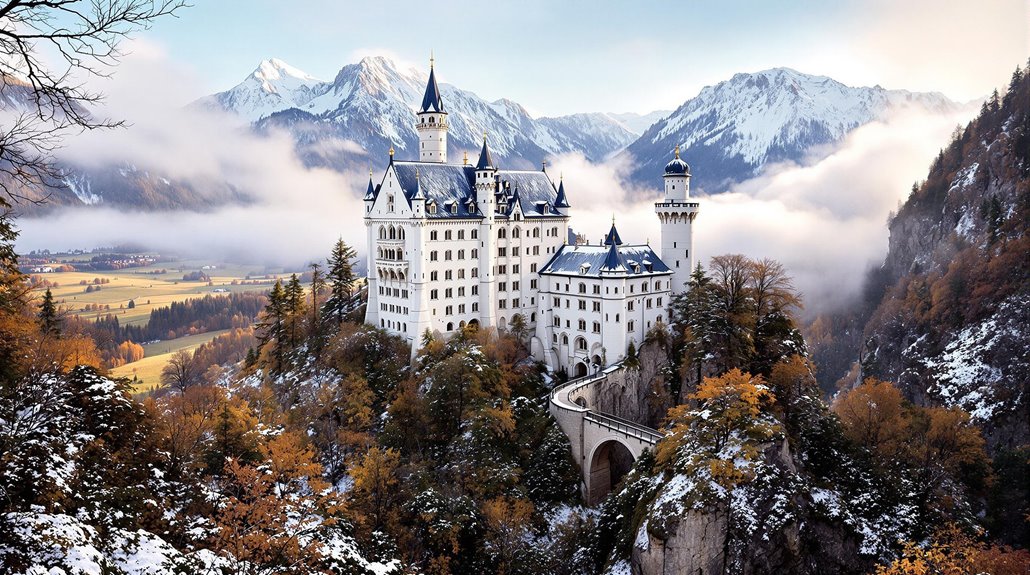
Germany’s most enchanting destinations combine rich history with modern culture. You’ll discover the fairytale-like Neuschwanstein Castle, Berlin’s iconic Brandenburg Gate, and Munich’s lively Oktoberfest celebrations. Don’t miss Hamburg’s stunning Elbphilharmonie, the medieval charm of Heidelberg Castle, or the natural wonders of the Black Forest and Baltic Coast. From Leipzig’s musical heritage to Europa-Park’s thrills, these destinations offer unforgettable experiences that’ll make you want to explore even more German treasures.
Standing proudly at the heart of Berlin, the Brandenburg Gate represents one of Germany’s most iconic landmarks and a powerful symbol of the country’s reunification.
The Brandenburg Gate stands as a majestic testament to German unity, watching over Berlin’s historic center like a steadfast guardian.
You’ll be amazed by this neoclassical masterpiece, built between 1788 and 1791, with its impressive 12 Doric columns and the magnificent Quadriga statue crowning its top.
For the best experience, visit during spring or autumn when crowds are thinner, and don’t miss seeing it illuminated at night.
You can easily reach the gate via the Brandenburger Tor station, and since it’s open 24/7, you’re free to explore at your convenience.
The gate’s design was heavily influenced by Athens’ Propylaea, creating a stunning example of Greek-inspired architecture in the heart of Germany.
While you’re there, take advantage of its central location to visit nearby attractions like the Reichstag Building, the Holocaust Memorial, and the peaceful Tiergarten Park.
The city’s rich history and cultural allure make Berlin one of Europe’s most captivating capital cities to explore.
Take a guided walking tour to learn about the gate’s role as a historic border crossing during Germany’s division.
Perched atop a rugged hill in Bavaria, Neuschwanstein Castle stands as Germany’s most celebrated palace and the ultimate expression of 19th-century Romantic ideals.
Built between 1868 and 1886 by King Ludwig II, this architectural masterpiece blends Romanesque, Gothic, and Byzantine styles while featuring modern innovations like central heating and running water.
The castle’s construction required massive quantities of materials, including 465 tonnes of marble and 400,000 bricks to create its magnificent structure.
You’ll need to join a guided 30-35 minute tour to explore the castle’s stunning interiors, where swan motifs and Wagner-inspired designs dominate the decor.
Tickets cost €17-18 for adults, while entry is free for those under 18. Since the castle welcomes over 1.5 million visitors annually, with summer peaks exceeding 6,000 daily visitors, it’s crucial to book your tour in advance.
The palace’s fairy-tale appearance later inspired Walt Disney’s iconic castle design.
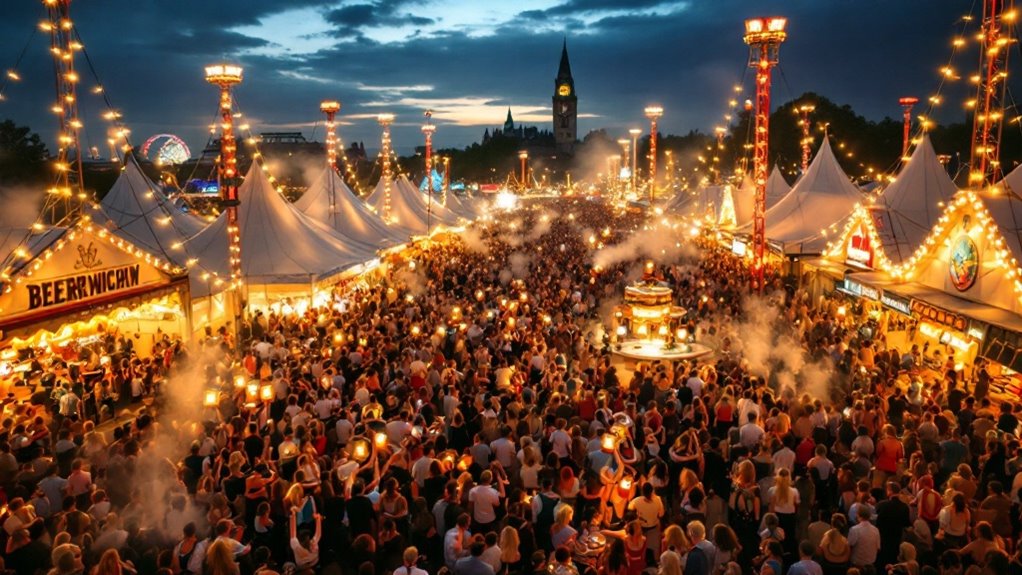
When the crisp autumn air settles over Munich each September, the world’s largest folk festival transforms the Theresienwiese grounds into a spectacular celebration of Bavarian culture and heritage.
You’ll discover six historic Munich breweries serving their finest beers in massive tents, where traditional brass bands play a mix of folk songs and modern hits. The festival’s evolution into an electrified wonderland began in 1886 with electricity being installed throughout the grounds, creating a magical evening atmosphere.
Don’t miss the opening ceremony, where Munich’s mayor taps the first keg with the famous “O’zapft is!” proclamation.
You’ll want to book your accommodations and beer tent reservations months in advance, as millions of visitors flock to this 16-day celebration.
While you’re there, sample authentic Bavarian dishes like Hendl (roasted chicken) and Schweinshaxe (pork knuckle), and embrace the festive spirit by wearing traditional dirndl or lederhosen.
High above the Neckar River, the majestic ruins of Heidelberg Castle tell an 800-year story of German history, romance, and resilience.
You’ll discover Renaissance masterpieces like the Ottheinrichsbau and Friedrichsbau, along with the world’s largest wine barrel in the castle’s cellar. For the best views, take the historic funicular railway from the Old Town to the castle, where you can explore Gothic and Baroque architectural elements from various rebuilding periods.
Originally commissioned by prince electors, the Hortus Palatinus garden was never fully realized despite being hailed as the eighth wonder of the world.
Don’t miss the charming Altstadt below, where you can stroll along Europe’s longest pedestrian street, Hauptstraße.
Make your way to the Karl-Theodor Bridge for the traditional tourist ritual at the Brückenaffe statue, then climb the Philosophenweg for panoramic views of the castle and Neckar Valley.
Time your visit for the castle’s spectacular fireworks displays, which commemorate historical sieges.
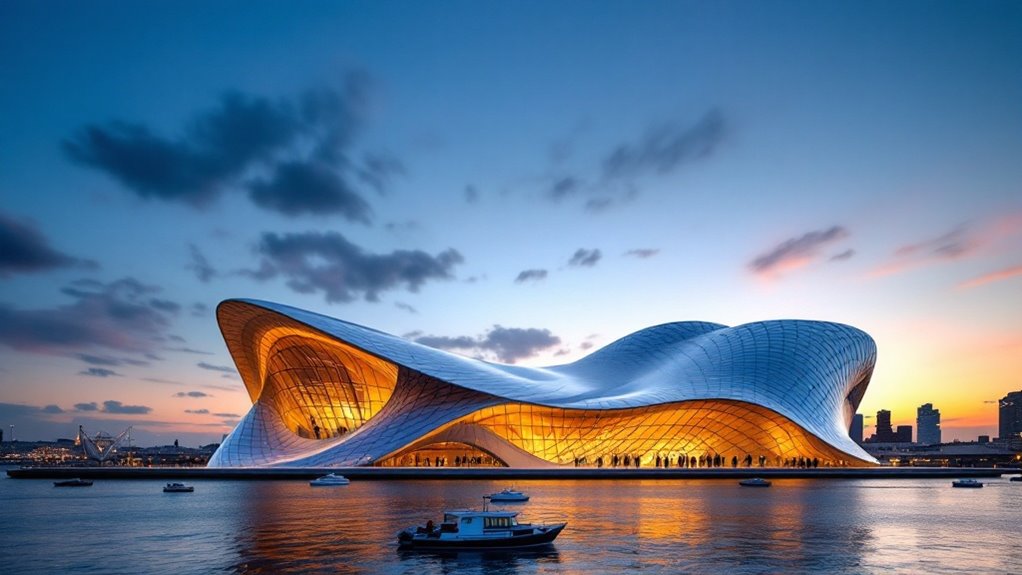
Rising dramatically from Hamburg’s harbor, the Elbphilharmonie stands as Germany’s most ambitious modern cultural landmark.
You’ll be captivated by its striking design, which combines a historic brick warehouse base with an undulating glass superstructure featuring 1,100 curved panels.
The building’s crown jewel is its 37-meter-high public viewing platform, offering breathtaking 360-degree views of the harbor and city. The venue houses a magnificent main concert hall that seats 2,100 people, making it one of Europe’s largest performance spaces.
Located just minutes from the vibrant Kreuzberg district, the Elbphilharmonie offers easy access to Berlin’s diverse culinary scene.
To make the most of your visit:
Stretching across southwestern Germany for 160 kilometers, the Black Forest captivates visitors with its pristine wilderness, dramatic landscapes, and natural wonders that rival Europe’s finest.
You’ll discover the UNESCO-listed Biosphere Reserve, where traditional farming has shaped a stunning mosaic of forests and meadows.
Don’t miss the seven-tiered Triberg Waterfalls, one of Germany’s highest cascades at 163 meters, or the crystal-clear waters of Lake Titisee, perfect for swimming and boating.
The enchanting region is particularly beautiful during warmer months when flowering meadows create a colorful tapestry across the landscape.
For hiking enthusiasts, the historic Westweg Trail offers 290 kilometers of adventure from Pforzheim to Basel, while the Schluchtensteig Trail leads you through seven dramatic gorges.
Keep your eyes peeled for rare wildlife, including peregrine falcons and Europe’s smallest owl, the pygmy owl.
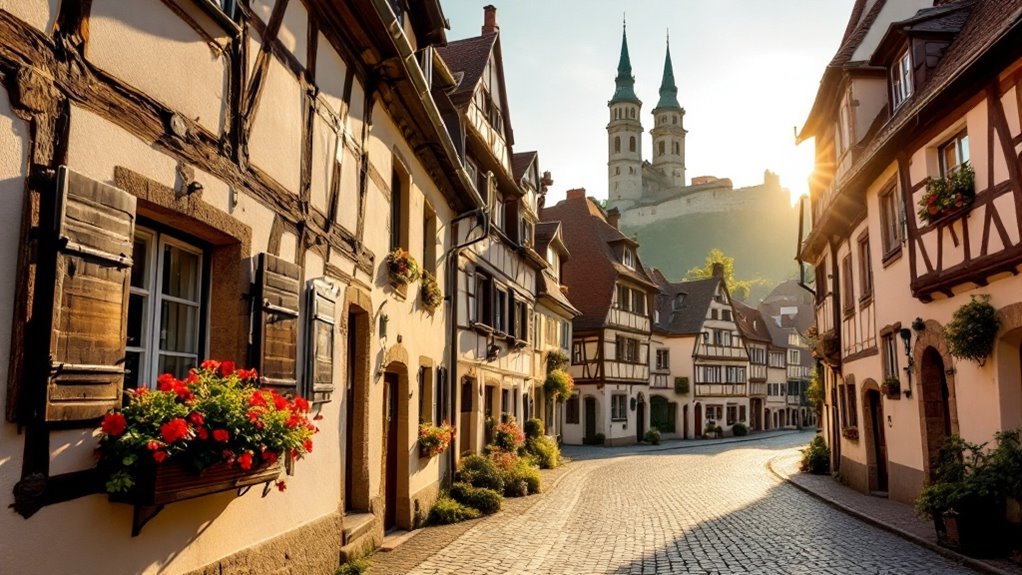
Nestled along Bavaria’s famous Romantic Road, Rothenburg ob der Tauber stands as Germany’s best-preserved medieval town, transporting visitors back to the 13th century with its enchanting architecture and authentic charm.
Step back in time as you discover Rothenburg ob der Tauber, where medieval Germany comes alive in stunning architectural splendor.
You’ll encounter yourself surrounded by half-timbered houses, ancient towers, and a remarkably intact 4-kilometer city wall that’s perfect for a scenic walk. Traditional German culinary delights await visitors at local restaurants and cafes, featuring regional specialties and wines.
Don’t miss the iconic Plönlein corner, where you’ll capture the town’s most photographed view featuring two medieval towers and traditional German architecture.
The Master Builder’s House offers fascinating Renaissance carvings that tell stories of virtue and vice.
While Rothenburg celebrates medieval heritage, Dresden stands as a symbol of cultural rebirth and artistic brilliance.
You’ll discover a city that’s risen from the ashes of WWII to reclaim its status as Germany’s cultural jewel, with the meticulously reconstructed Frauenkirche serving as its crowning achievement.
Don’t miss the Zwinger Palace, where you can explore Europe’s finest art collections, or the restored Dresden Castle, home to the dazzling Green Vault’s collection of over 3,000 precious artifacts.
For classical music enthusiasts, the Semperoper offers world-class performances in a stunning Baroque setting. The city hosts the beloved annual Striezelmarkt Christmas market, one of Germany’s largest and most enchanting holiday celebrations.
As you walk through the beautifully restored Neumarkt district, you’ll see how Dresden has masterfully blended its historical Baroque architecture with contemporary energy, making it an essential stop on any German cultural tour.
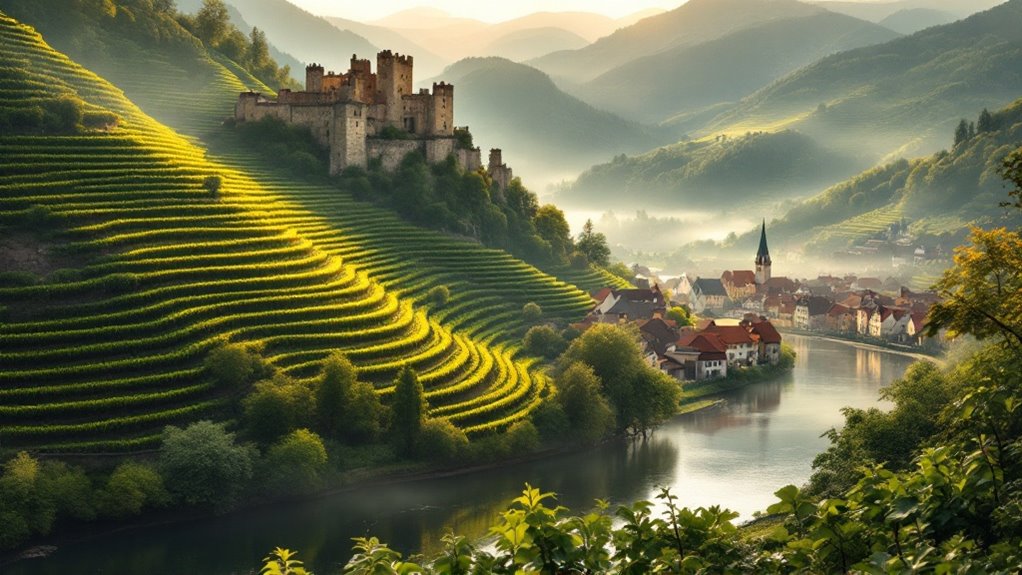
The majestic Rhine Valley stands as Germany’s most enchanting wine region, where steep terraced vineyards cascade down dramatic hillsides between Bingen and Bonn.
Terraced vineyards gracefully tumble down the hills of Germany’s Rhine Valley, creating a mesmerizing patchwork of emerald slopes.
You’ll discover a UNESCO-listed landscape where Medieval castles crown hilltops and historic towns retain their original walls, creating a perfect blend of culture and viticulture. The region’s unique clayish slate and greywacke soils contribute to the distinctive character of local wines.
When exploring this remarkable region, you’ll want to:
Don’t miss the spectacular Rhein in Flammen fireworks festival, where illuminated castles create an unforgettable backdrop to your wine-tasting adventure.
Moving from the sun-drenched vineyards of the Rhine Valley, Germany’s winter wonderland beckons at Nuremberg’s Christmas Market, where centuries-old traditions come alive in the city’s medieval Hauptmarkt square.
You’ll discover this enchanting market running from late November through December 24th, operating daily from 10 AM to 9 PM. As you explore the 200 traditional stalls, don’t miss the iconic Nuremberg sausages and spiced Lebkuchen gingerbread, served alongside warming Feuerzangenbowle in collectible mugs.
Make sure to catch the Christkind’s opening ceremony, where a golden-haired angel recites the historic prologue at 5:30 PM on the Friday before Advent. The market has become one of Germany’s most beloved holiday destinations, attracting two million visitors annually.
For family fun, head to the Kinderweihnacht area, where your children can enjoy cookie baking and carousel rides while you browse handcrafted ornaments and nutcrackers.
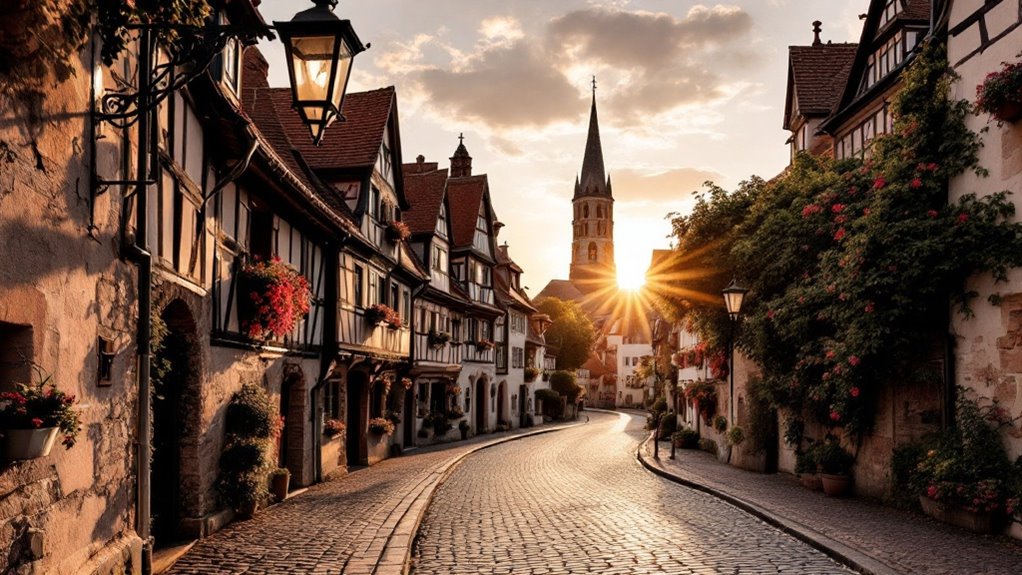
Stretching majestically from Würzburg to Füssen, Germany’s legendary Romantic Road beckons travelers with its 350-kilometer journey through medieval towns, pastoral landscapes, and fairy-tale castles.
You’ll discover this post-WWII tourism route’s rich blend of history and culture, from UNESCO-listed sites to perfectly preserved medieval towns like Rothenburg ob der Tauber.
The route’s popularity initially soared as American soldiers’ families discovered its charms while stationed in post-war Germany.
For the best experience along this iconic route:
While you can cycle the parallel D9 trail or join guided tours, self-driving lets you explore hidden gems and charming villages at your own pace.
Soaring heavenward with its twin Gothic spires, Cologne Cathedral stands as Germany’s most visited landmark and a masterpiece of medieval architecture. You’ll be awestruck by the world’s largest church façade, where 157-meter towers pierce the sky. Inside, you can explore a treasure trove of medieval art, including the renowned Gero Crucifix and intricately carved choir stalls. The cathedral houses the magnificent Shrine of the Three Kings, a masterwork containing the relics of the Magi.
| Feature | Detail | Best Time to Visit |
|---|---|---|
| Height | 157 meters | Morning light |
| Length | 144.5 meters | Midday tours |
| Windows | 11,000 sq meters | Afternoon glow |
| Construction | 1248-1880 | Year-round |
| Style | French Gothic | Any season |
Don’t miss the spectacular stained glass windows, which create a mesmerizing play of colored light throughout the vast interior spaces. The cathedral’s UNESCO World Heritage status reflects its exceptional preservation of Gothic architectural principles.
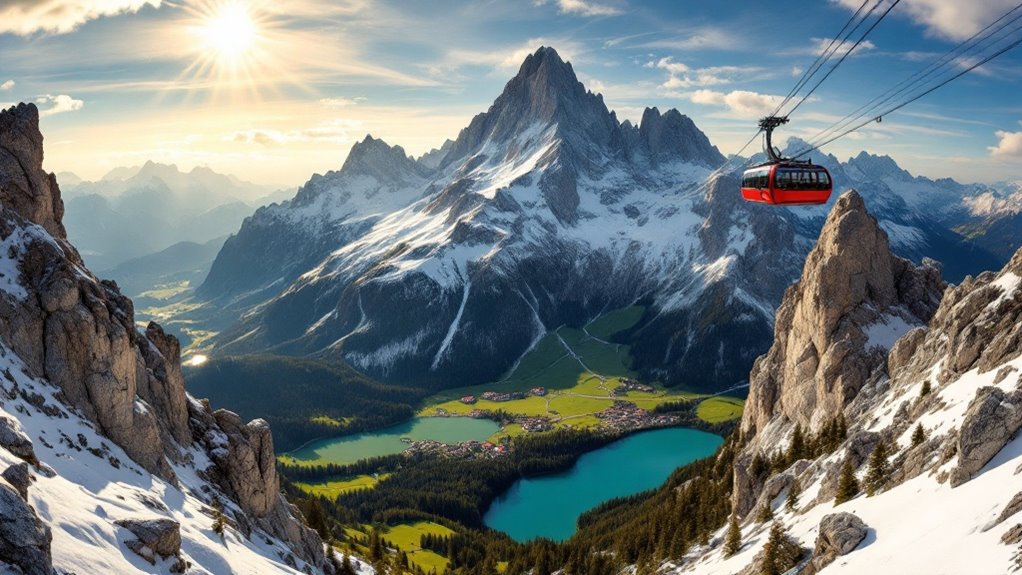
At the crown of Germany’s alpine domain, the majestic Zugspitze peak beckons adventurers to its towering height of 2,962 meters, where you’ll discover a world of year-round snow, glacial landscapes, and panoramic views spanning four countries.
Whether you’re an experienced mountaineer or a casual tourist, there’s a way for everyone to experience Germany’s highest peak.
The historic capital city of Berlin may be far from this alpine paradise, but it’s worth the journey south to experience Bavaria’s natural wonder. You’ll find year-round activities, but winter brings special charm with the unique Iglu-Dorf ice village experience and extensive skiing opportunities. The mountain welcomes approximately 500,000 visitors to its summit each year via its efficient cable car system.
Deep within Hamburg’s historic Speicherstadt district, you’ll discover Miniatur Wunderland, the world’s largest model railway system and Germany’s most visited tourist attraction.
You’ll be amazed by the sheer scale: over 16,491 meters of track featuring 1,230 digitally controlled trains and a mesmerizing 15-minute day-night cycle powered by 500,000 LED lights.
As you explore nine distinct sections, from the Harz mountains to a meticulously detailed Hamburg Airport replica, you can trigger interactive displays with 200 control buttons, launching helicopters or activating the Space Shuttle.
The attraction showcases 4,340 buildings and bridges throughout its expansive display, each crafted with incredible attention to detail.
Don’t miss the fictional town of Knuffingen, where 100+ cars navigate streets autonomously, or the working Lindt chocolate factory that dispenses real samples.
The attraction’s guided backstage tours offer priority access and behind-the-scenes insights into this technological marvel.
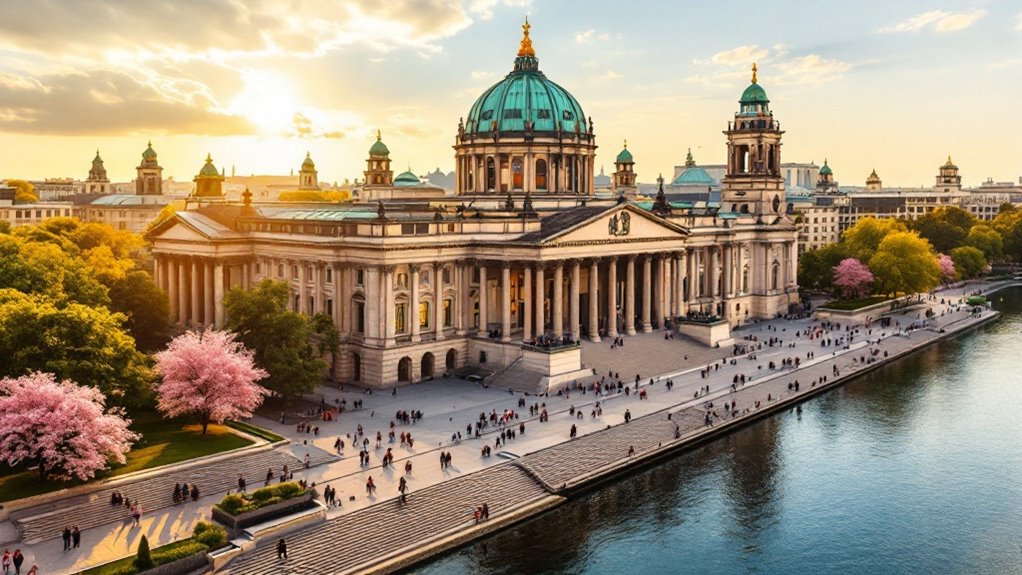
Nestled in the heart of Berlin’s historic center, Museum Island stands as one of Europe’s most remarkable cultural treasures, where five world-class museums showcase over 6,000 years of human artistic achievement.
You’ll uncover a UNESCO World Heritage site that’s been carefully restored and enhanced with modern amenities, including the new James Simon Gallery visitor center. The complex has undergone extensive renovations since the 1990s, with the federal government funding providing crucial support for restoration projects.
Spanning Germany’s northern coastline, the Baltic Sea region enchants visitors with its dramatic chalk cliffs, pristine beaches, and rich biodiversity across five distinct national parks and protected areas.
You’ll discover the most spectacular views at Jasmund National Park on Rügen Island, where 161-meter white chalk cliffs tower above ancient beech forests.
Don’t miss the Hochuferweg trail, an 8-kilometer coastal path offering breathtaking vistas from the Ernst-Moritz-Arndt-Sicht viewpoint.
Hike the scenic Hochuferweg coastal trail to experience stunning clifftop views from the iconic Ernst-Moritz-Arndt-Sicht overlook.
For wildlife enthusiasts, the Vorpommersche Boddenlandschaft National Park provides Europe’s largest crane resting area, where you can observe thousands of migratory birds.
The car-free Hiddensee Island offers a peaceful retreat with its untouched dunes and heathlands, while the UNESCO-listed Wadden Sea tidal flats host an incredible variety of marine life.
Along the shoreline, visitors can explore the historic Warnemünde Lighthouse, a beloved maritime landmark offering panoramic views of the Baltic Sea.
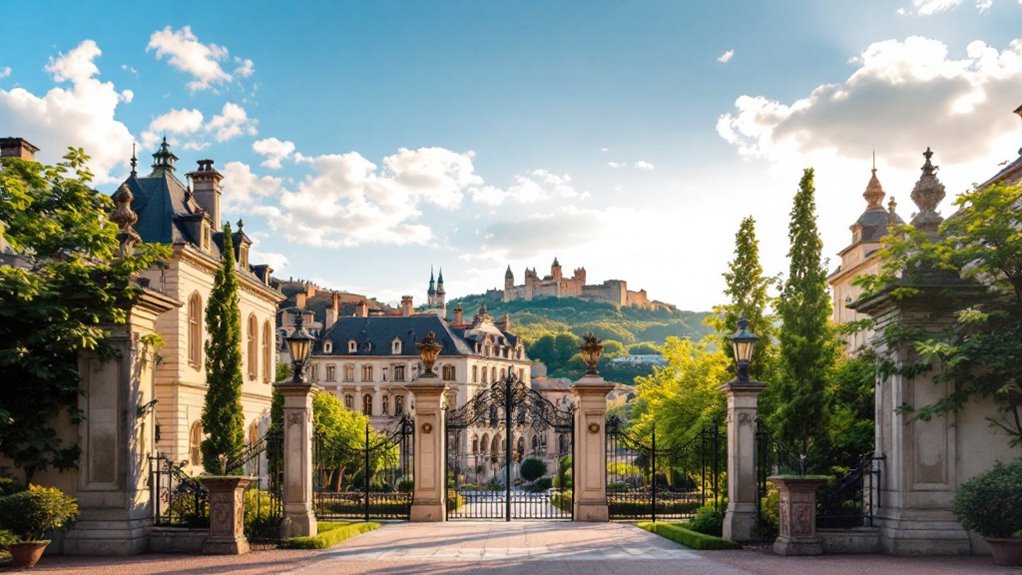
Standing as one of Europe’s finest Baroque palaces, the Würzburg Residence showcases an extraordinary blend of French, Italian, and Austrian architectural influences that you’ll discover throughout its grand halls and meticulously restored chambers.
The palace, a UNESCO World Heritage Site since 1981, offers daily guided tours in English and German, making it easy to explore its rich history and stunning artworks. Commissioned in 1720, this architectural masterpiece was designed by the renowned court architect Balthasar Neumann.
Don’t miss these highlights during your visit:
Plan about 2-3 hours for your visit, and remember to arrive at least 30 minutes before closing.
As one of Europe’s most significant musical capitals, Leipzig resonates with centuries of classical music history that you’ll discover throughout its historic venues and cultural landmarks.
You can explore Bach’s legacy at St. Thomas Church, where he served as cantor for 27 years and where the renowned St. Thomas Boys Choir still performs today. Don’t miss the Bach Museum, featuring original manuscripts and family artifacts.
Follow the 5.6-kilometer Leipzig Music Trail to connect nine historic sites, including Mendelssohn House and Schumann House. For live performances, head to the Gewandhaus Concert Hall, home to one of the world’s oldest orchestras.
Here, you’ll experience the same venue where Mendelssohn famously revived Bach’s St. Matthew Passion in the 19th century. Classical music enthusiasts can also visit the Leipzig Opera House, which regularly stages productions of Wagner’s operas.
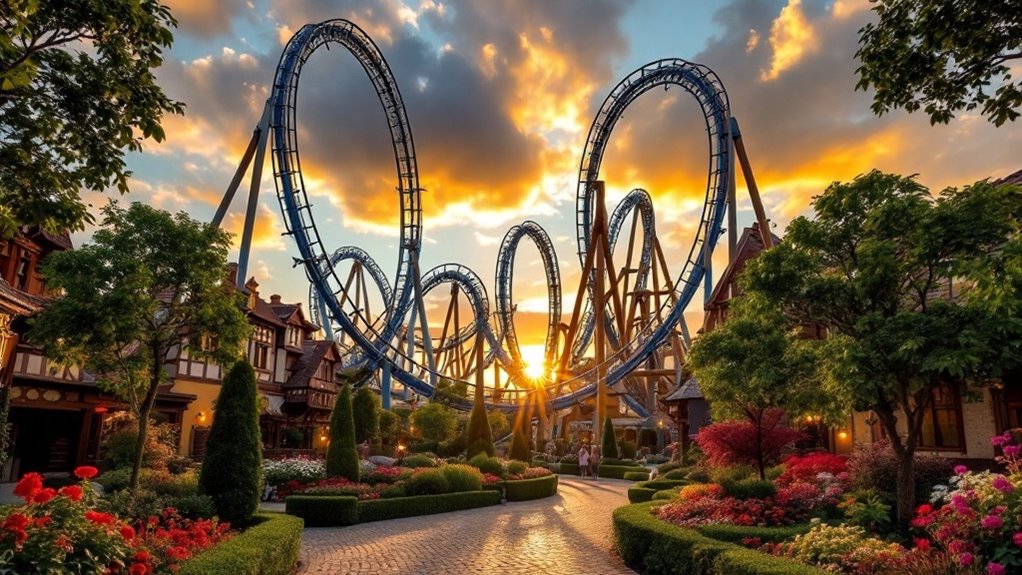
Located in the charming town of Rust near the French border, Europa-Park stands as Germany’s largest and most spectacular theme park, where you’ll discover over 100 attractions spread across 95 hectares of entertainment paradise.
You’ll need at least two days to explore the park’s 16 European-themed areas, featuring thrilling roller coasters and immersive experiences like the Voletarium flying theater. The park’s remarkable growth is evident in its visitor numbers, reaching six million visitors in 2022.
For the best experience at Europa-Park, consider these essential tips:
You will discover the smallest crowds in January-February when tourism drops 18% after holidays. Winter’s snowfall and cold weather reduce visitors by 40% at major attractions, plus you will enjoy 25-35% lower hotel rates.
With a 5-day pass averaging €45/day, you will discover rail passes worthwhile if you’re planning multiple long-distance trips. They’re especially valuable for last-minute travel and when you want complete scheduling flexibility.
You will discover the most affordable housing in eastern cities like Leipzig, Halle, and Chemnitz, where monthly rents average €350-600. Western cities like Bielefeld and Krefeld also offer budget-friendly accommodation options.
You don’t need German language skills for tourist travel. English is widely spoken in major cities and tourist areas. Basic phrases like “danke” and “bitte” are helpful but not mandatory.
Like a gentle handshake, German tipping’s modest: you’ll tip 5-10% for good service, 15% for exceptional care. Simply round up your bill and say “stimmt so” to let servers keep the change.
With over 37 million international visitors annually, Germany’s diverse attractions offer something for every traveler. You will be captivated by fairy-tale castles, lively festivals, and rich cultural heritage across these 19 destinations. Whether you’re drawn to Berlin’s historic landmarks, Bavaria’s alpine charm, or Hamburg’s maritime spirit, you will discover that Germany’s blend of old-world wonder and modern innovation creates an unforgettable travel experience you won’t want to miss.